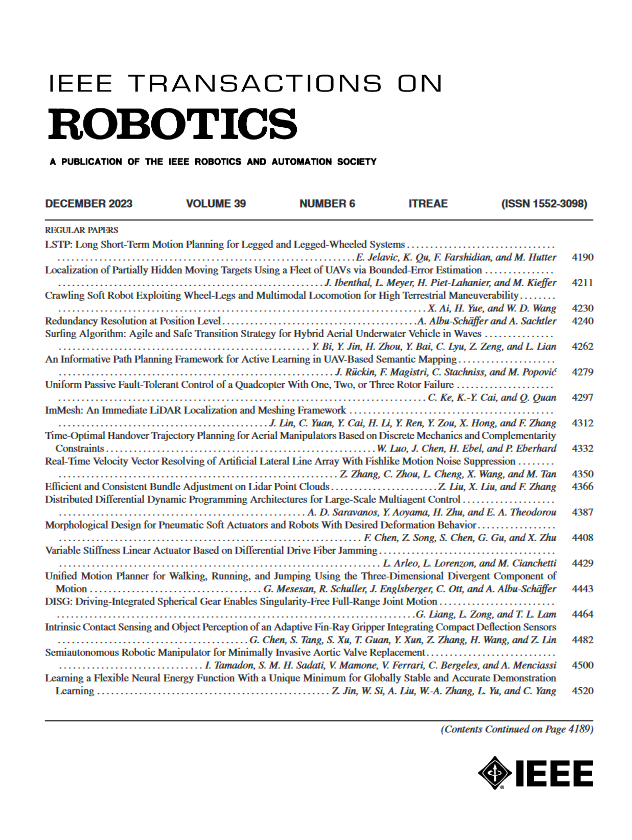触觉弹性成像
IF 10.5
1区 计算机科学
Q1 ROBOTICS
引用次数: 0
摘要
弹性是反映软质材料力学性能的代表性参数之一。探测物体下方的弹性分布(称为弹性成像)是理解物体并与之交互的关键步骤。现有的捕获内部弹性分布的方法通常依赖于昂贵的仪器。本文将高分辨率视觉触觉传感器捕获的密集触觉信号作为一种重建三维弹性分布的新方式。我们提出了一种基于模型的方法,该方法利用来自主动按压试验的触觉映射来完成弹性成像任务。利用逆物理模型重构了非刚体的内部弹性分布。我们分析了用我们的方法得到的估计弹性分布的可信度。还讨论了不同的设计因素。我们在机器人辅助场景中的一组合成三维模型和物理模型上进行了实验。各种实验结果的收集,证明了我们的方法在感知弹性分布的有效性。本文章由计算机程序翻译,如有差异,请以英文原文为准。
Tactile Elastography
Elasticity is one of the representative parameters that reflect the mechanical properties of soft materials. Detecting the underneath elasticity distribution called elastography is a key step for understanding and interacting with objects. Existing solutions for capturing the interior elasticity distribution typically rely on expensive apparatus. In this work, the dense tactile signal captured by the high-resolution vision-based tactile sensor is introduced as a new modality for reconstructing 3-D elasticity distribution. We propose a model-based method, which exploits the tactile maps from active pressing trials for the elastography task. The interior elasticity distribution for nonrigid objects is reconstructed from an inverse physics model. We analyze the credibility of the estimated elasticity distribution obtained from our method. Varying design factors are also discussed. We experiment our method on a set of synthesized 3-D models and physical models in robot-assisted scenes. Various experimental results have been gathered, demonstrating the efficacy of our approach in perceiving elasticity distribution.
求助全文
通过发布文献求助,成功后即可免费获取论文全文。
去求助
来源期刊

IEEE Transactions on Robotics
工程技术-机器人学
CiteScore
14.90
自引率
5.10%
发文量
259
审稿时长
6.0 months
期刊介绍:
The IEEE Transactions on Robotics (T-RO) is dedicated to publishing fundamental papers covering all facets of robotics, drawing on interdisciplinary approaches from computer science, control systems, electrical engineering, mathematics, mechanical engineering, and beyond. From industrial applications to service and personal assistants, surgical operations to space, underwater, and remote exploration, robots and intelligent machines play pivotal roles across various domains, including entertainment, safety, search and rescue, military applications, agriculture, and intelligent vehicles.
Special emphasis is placed on intelligent machines and systems designed for unstructured environments, where a significant portion of the environment remains unknown and beyond direct sensing or control.
 求助内容:
求助内容: 应助结果提醒方式:
应助结果提醒方式:


